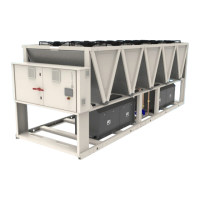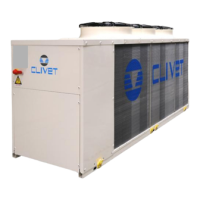30
WSAN-YES 18.2-35.2
M0ST10N19-00
Check for water side exchanger pressure drops:
Determine the water flow rate.
Measure the difference in pressure between
exchanger input and output and compare it with
the graph on WATER SIDE EXCHANGER PRESSURE
DROPS
The measurement of pressure will be easier if
pressure gauges are installed as indicated in the
DIAGRAM OF SUGGESTED WATER CONNECTIONS.
Scroll compressor
Scroll compressors have only one rotation direction.
In the event it is reversed, the compressor is not
immediately damaged, but increases its noise and
jeopardises pumping.
After a few minutes the compressor shuts down due
to the thermal protection tripping.
In this case, disconnect the power supply and invert
2 phases on the machine power supply.
Do not let the compressor work for a long time
with opposite rotation: more than 2-3 of these
abnormal start-ups can damage it.
To ensure the rotation direction is correct, measure
the condensation and suction pressure.
The pressures must significantly differ: upon start-
up, the suction pressure decreases while the
condensation one increases.
Reduced load operation
The units are equipped with partialisation steps and
so can operate with reduced loads.
However, a constant and long operation with
reduced load with frequent compressor(s) stops and
start-ups can cause irreparable damages for the
absence of oil return.
The above-described operating conditions must be
considered outside the operating limits.
If the compressor breaks down due to operating in the
above-mentioned conditions, the warranty shall no
longer be valid and CLIVET spa shall not accept any
liability.
Periodically check the average operating times and
frequency of compressor start-ups: indicatively the
minimum thermal load must be such as to require
a compressor to operate for at least ten minutes.
If the average times are close to this limit, take the
proper corrective actions.
.
Start-up report
Dentifying the operating objective conditions is
useful to control the unit over time.
With unit at steady state, i.e. in stable and close-to-
work conditions, identify the following data:
Total voltages and absorptions with unit at full
load
Absorptions of the different electric loads
(compressors, fans, pumps etc)
Temperatures and flows of the different fluids
(water, air) both in input and in output from the
unit
Temperature and pressures on the characteristic
points of the refrigerating circuit (compressor
discharge, liquid, intake)
The measurements must be kept and made
available during maintenance interventions.
2014/68/UE PED Directive
2014/68/UE PED DIRECTIVE gives instructions for
installers, users and maintenance technicians as
well.
Refer to local regulations; briefly and as an
example, see the following:
Compulsory verification of the first installation:
only for units assembled on the installer’s
building site (for ex. Condensing circuit + direct
expansion unit)
Certification of setting in service:
for all the units
Periodical verifications:
to be executed with the frequency indicated by
the Manufacturer (see the “maintenance
inspections” paragraph)
7 START-UP

